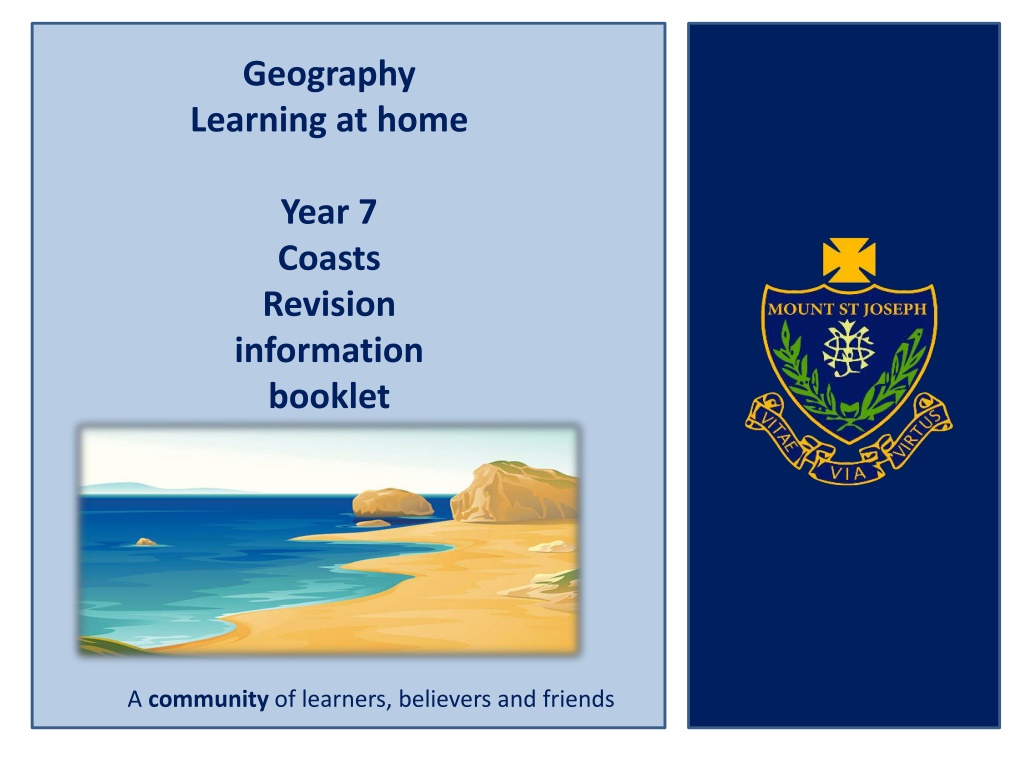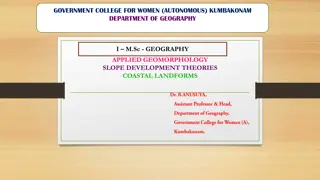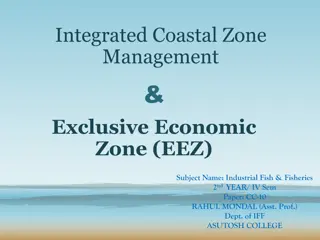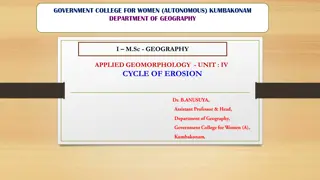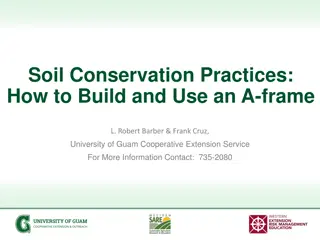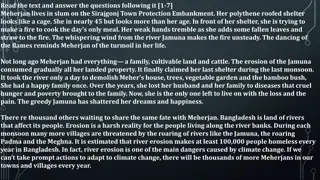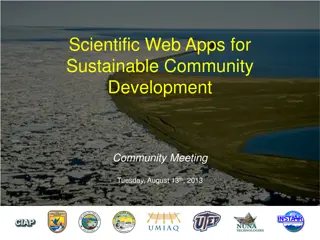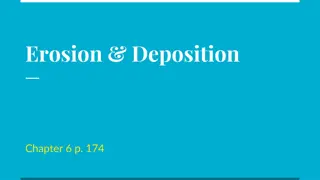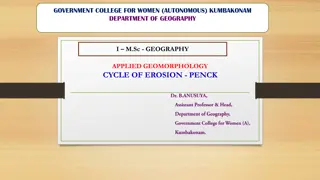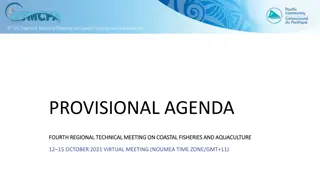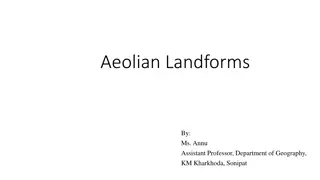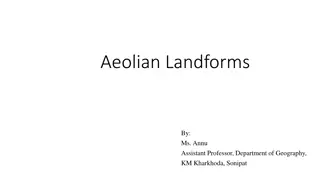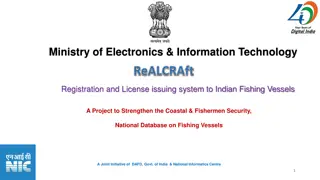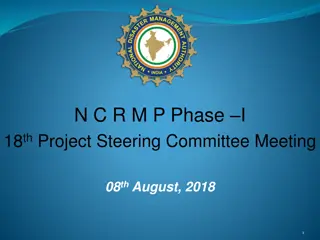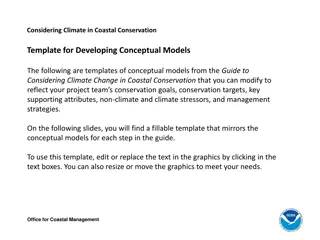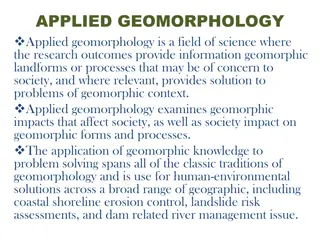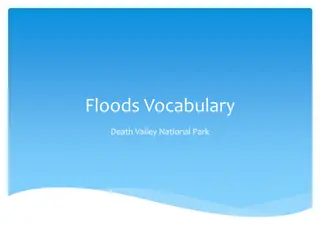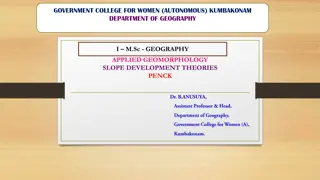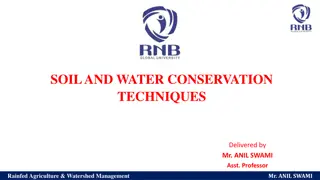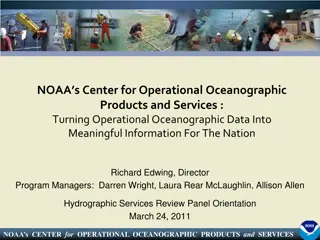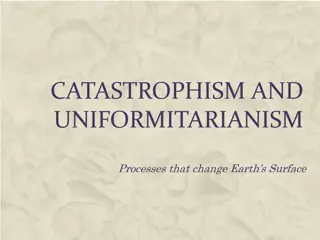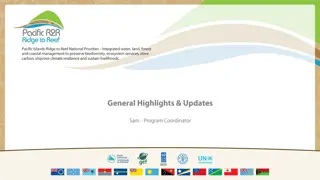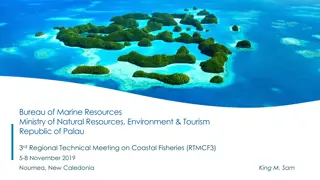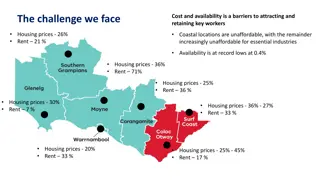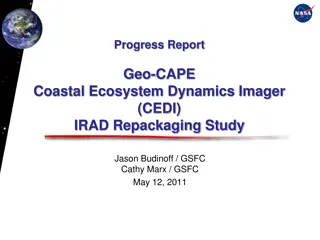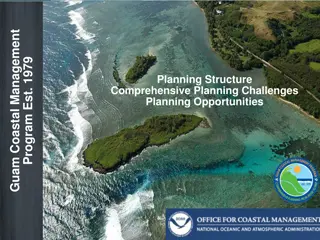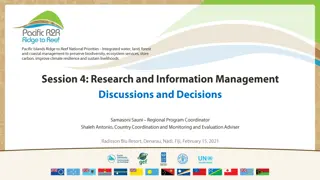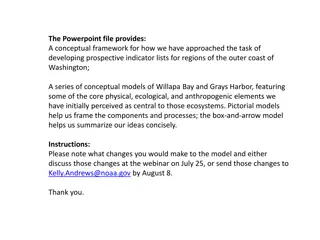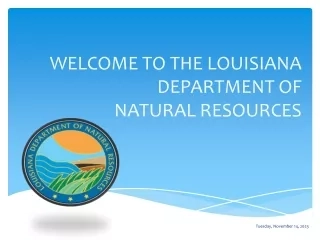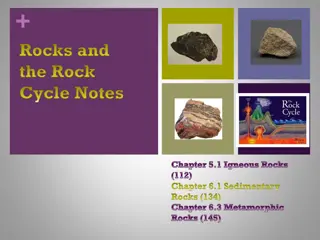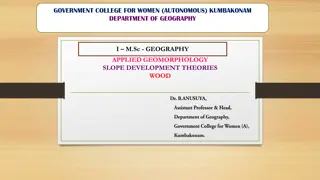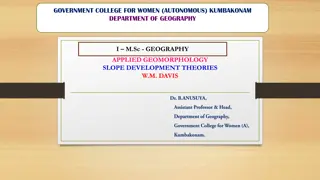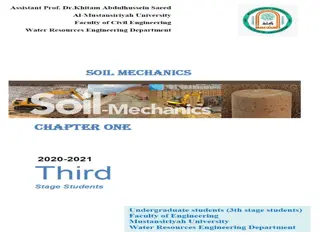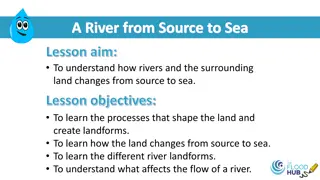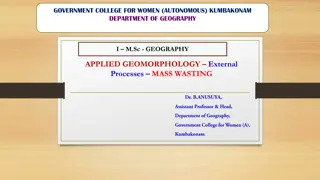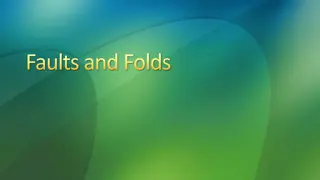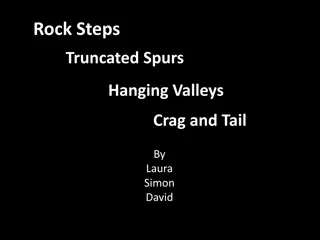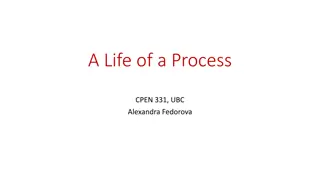Understanding Coastal Processes and Erosion
Coasts are dynamic environments shaped by a variety of processes such as erosion and transportation. Waves influence the size and energy of waves, while erosion is caused by processes like corrasion and solution. Coastal transportation involves suspension, solution, and saltation. The impact of marine and sub-aerial processes, as well as cliff collapse, further shape coastlines. Understanding these mechanisms is crucial for comprehending coastal geography.
Download Presentation

Please find below an Image/Link to download the presentation.
The content on the website is provided AS IS for your information and personal use only. It may not be sold, licensed, or shared on other websites without obtaining consent from the author. Download presentation by click this link. If you encounter any issues during the download, it is possible that the publisher has removed the file from their server.
E N D
Presentation Transcript
Geography Learning at home Year 7 Coasts Revision information booklet A community of learners, believers and friends
The size and energy of a wave is influenced by: how long the wind has been blowing the strength of the wind how far the wave has travelled (the fetch) Types of waves Destructive Destroys (takes beach away) Strong backwash Weak swash Constructive Creates (put sand on the beach) Strong swash Weak backwash
These processes erode material at the coast and in a river. Coastal erosional processes Corrasion/Abrasion Hydraulic action Eroded rocks rub against the channel/thrown against the cliff wearing it away. The force of the water breaks rock particles away from the river channel/cliff. Corrosion/Solution River/sea dissolves some types of rock such as chalk and limestone. Attrition Coastal erosion is affected by: The point at which the wave breaks Steepness of the wave. Rock type and structure - (hard rock such as granite is far more resistant to erosion than soft rocks, such as clay). Eroded rocks picked up by the river/waves smash into each other.
These processes move material at the coast and in a river. Coastal transportation processes Suspension Small particles are carried along by the water. Solution Soluble materials dissolve in water and are carried along. Saltation Traction Large particles like boulders are pushed along the bottom of the river bed/sea by the force of the water. Pebble sized particles are bounced along the river bed/sea by the force of the water.
Cliff collapse Marine processes- the sea erodes by erosional processes Chemical weathering- includes solution where water reacts with calcium carbonate in rocks. Why? Sub-aerial processes such as weathering Mechanical weathering- includes freeze thaw when water gets into cracks and expands and contracts. Mass movement Sliding- this is when large chunks of rock slide down the slope quickly without any warning. This can make is dangerous to walk along the beach. Slumping- this is when the cliffs are made of clay. The clay becomes saturated during heavy rainfall and oozes down towards the sea.
Coastal transportation processes- longshore drift Erosion Deposition Swash Backwash Prevailing wind 1 Waves approach the beach at a slight angle influenced by the prevailing wind. As the waves break the swash carried the material up the beach at the same angle. 2 As the swash dies away the backwash and any material carried by it falls straight back down the beach. 3 The means that material is moved along the beach in a zig-zag route. 4
Coastal erosional landforms Wave cut notch and platform Wave cut platform Weather weakens the top of the cliff. 1 The sea attacks the base of the cliff forming a wave cut notch. 2 The notch increases in size causing the cliff to collapse. 3 The backwash carries the rubble back to the sea forming a wave cut platform. 4 The process repeats itself and the cliff continues to retreat. 5
Coastal erosional landforms Headland and bays The sea attacks a discordant coasta line an area of coast with alternating bands of hard and soft rock. 1 The soft rock (sand or clay) are eroding more quickly. 2 Headlands and bays This creates a bay. 3 The hard rock is more resistant and takes longer to erode. 4 This leaves a headland jutting out to sea. 5
Coastal erosional landforms coastal stack Hydraulic action creates cracks in the headland. 1 Overtime the hydraulic action causes the crack to become deeper. 2 Headland erosion This creates a cave. This may eventually break through. 3 This creates an arch. The arch will eventually become bigger and collapse. 4 This leaves a stack. Forces of erosion turn the stack into a stump. 5
Coastal depositional landforms Deposition occurs when the sea deposits material on the beach. This occurs because of a change in direction of the coastline, the waves lose energy, erosion is happening rapidly along the coast or the waves are constructive. Beaches Constructive waves help to build up beaches. 1 The soft rock (sand or clay) are eroding more quickly. 2 This creates a bay. 3 4 The hard rock is more resistant and takes longer to erode.
Coastal depositional landforms Spits Longshore drift moves material along the coastline. 1 A spit forms when the material is deposited. 2 Over time, the spit grows and develops a hook if wind direction changes further out. 3 Waves cannot get past a spit, which creates a sheltered area where silt is deposited and mud flats or salt marshes form. Bars 4 A bar forms when a spit joins to two headlands. 5
Coastal erosion case study Happisburgh, Norfolk Social impacts People loose their homes if they fall into the sea. Homes close to the cliff go down in value. It is difficult and expensive to insure houses close to the cliff. It is dangerous for people to walk along the coast as the cliff could collapse on them. Conflict arises when the local government are not doing anything. Case study facts Homes on the cliff have been valued at 1. Residents such as Di Wrightson have lost their businesses (she owns a guest house) The main road has been lost. 24 homes have fallen into the sea. By a rock for Happisburgh has been set up to raise money for sea defenses. Agriculture and tourism contribute to the economy significantly. The local government is pursuing a policy of managed retreat and so locals are having to fight for compensation-most are loosing everything. The village has a strong community with a light house, church and shops which will all be lost Economic impacts Environmental impacts Road and railways near the coast are under threat. Tourists may not visit because of danger. This affects local businesses such as hotels and cafes. The local economic value of the area decreases. Cliff collapse makes the area look unattractive. Cliff collapse causes wildlife habitats to be lost. Green land and farm land is lost.
Coastal management case study Happisburgh, Norfolk Eroding 12metres each year By 2055, loss of 20 more properties Loss of caravan park and farmland -A small village with a pub , tea shop, lighthouse, church and homes -850 population -Mainly farmland -No main roads -Historic records indicate that over 250 m of land were lost between 1600 and 1850. -The cliffs are soft clay, so erode very quickly. Weathering increases the erosion rate. The location of Happisburgh causes increasing problems with powerful waves from the North sea, which creates landslides from eroding the base of the cliff. Management case study Conflict from managed retreat Old Management (all 40 years old) -To repair revetment cost 5 million, not cost effective -Farmers lose land and livelihood -Insurance companies won t pay out -Increasing protest from locals to central government but g ment has said no. -Defences would cost more than the land and homes are worth. -Locals want compensation for the lack of management and for their homes collapsing into the sea. -The historical lighthouse has had to be moved further back from the edge of the cliff. -local campaign buy a rock for Happisburgh to raise money for private defences. -Revetments now damaged (from a storm) and not effective -Groynes were placed to stop the rate of erosion, however they are not helping enough. -Rock Armour now little effectiveness Increasing climate change and sea level rise are impacting and increasing erosion Managed Retreat- monitor but no management
Case study: Rising sea levels in the Maldives The Maldives is a small country made up of a group of 1000 islands in the Indian Ocean. It is the lowest country in the world. Tourism is very important providing 30% of the country s GDP. Global warming is blamed for the countries rising sea levels. Social impacts People will be forced to leave their homes and possibly become environmental refugees in neighboring countries. The total population is 400, 000. The traditional way of life will be lost. In Kandholhudhoo, a densely-populated island in the north of the Maldives, 60% of residents have volunteered to evacuate over the next 15 years. Tidal surges flood the peoples homes every fortnight, and recently hammered a 3m (9.8ft) hole in their concrete flood defences. Political impacts The whole country could disappear under water. The government is looking to other countries for help- Japan paid 99% of the $63m bill for a 3 m high wall to built around the capital Male. Politically it puts the government under a lot of pressure to sort it out. This in Feb 2012 the president was removed in what some have called a coup. Environmental impacts Economic impacts Coral reefs will die as they are bleached and the water gets deeper. The ecosystem associated with the reefs will be lost. Fish numbers are lowering as the ecosystem is being destroyed. As the sea levels rise the islands become more vulnerable to events such as tsunamis and coastal flooding. Rising sea levels could put an end to the tourism industry. As the coral reefs are affected by warming temperature so will diving tourism. The fishing industry will slowly disappear- the majority of Maldivians rely on this for their income and farming is not possible.
Why protect the coast? Loss of housing Deaths Water supplies affected Social Businesses on the edge Damage to infrastructure Loss of jobs Loss of tourism SSIs are threatened by erosion Economic House prices fall Environmental Floods damage farm land Ecosystems are affected as sea water has high salt content
Coastal management Groynes Hard engineering Easily destroyed South beaches a deprived of sediment Build up the beach Cheap Breakwater Gabions Long-term Beaches remain natural Expensive Unattractive Cages rust Short lifespan Cheap Efficient Rip-rap The boulders are good at absorbing wave energy Can easily be moved They need to be replaced Revetment Sea wall Expensive Creates a strong backwash which erodes under the barrier. Prevents erosion. Acts as a flood barrier They absorb the wave energy Expensive Need maintaining Creates a strong backwash
Coastal management The purpose of soft engineering is to work with the natural processes of the coast. Soft engineering Beach replenishment Beach replenishment Adding sand and sediment to the beach from the sea floor. Creates wider beaches. Protects from erosion and flooding Looks natural Taking material can kill organisms It is very expensive It has to be repeated Could affect tourism Managed retreat Managed retreat Creates new marshland habitats Fairly cheap Flooding is reduced May cause conflict due to lost land. Could affect peoples lives. Allowing a section of land to flood in order for plants to grow and therefore become a natural wave and flood barrier.
Case study: Coastal habitats Studland Bay Nature Reserve Environmental characteristics o The nature reserve includes sand dunes and heath. o In this type of environment there is a unique ecosystem. o The area is internationally important and is a conservation area managed by the National Trust. Species that inhabit the area A special grass called marram grass grows on the sand and holds the dunes together. This allows more vegetation to develop creating a natural heath. The low shrubs and small trees allow butterflies, insects, small animals and sea bird to survive. It is the richest 1000 hectares for wildflowers in the country. The area supports many rare bird such as the nightjar. The sand lizard is one of the native species. Where? Studland Bay is located in Dorset and is very popular with tourists. Up to 1.5 million people visit every year. Most tourists arrive by car. Strategies to ensure environmental conservation but sustainable use. o Vulnerable areas have been fenced off to limit access and damage. o Bird-watching hides and guided walks help visitors to enjoy the wildlife properly. o No driving on the beach and limited car parking spaces. o Specific paths have been created to keep visitors off the dunes. o Jet ski s are not allowed to be launched from the beach and a 5mph speed limit to reduce the noise. o Dogs are not allowed on the beach in the Summer. o Tourists are focused into one area with the facilities such as a shop and toilets. o Information boards to educate visitors about the wildlife Issues The nature reserve and sand dune are a vulnerable environment. The vegetation takes many years to establish. If the habitat is destroyed the eco-system will break down. It is home to rare species of plants and birds and all 6 British reptiles. The area attracts many tourists and gets very busy in the summer. Visitors need somewhere to park and other facilities such as paths and toilets Visitors bring problems such as litter.
